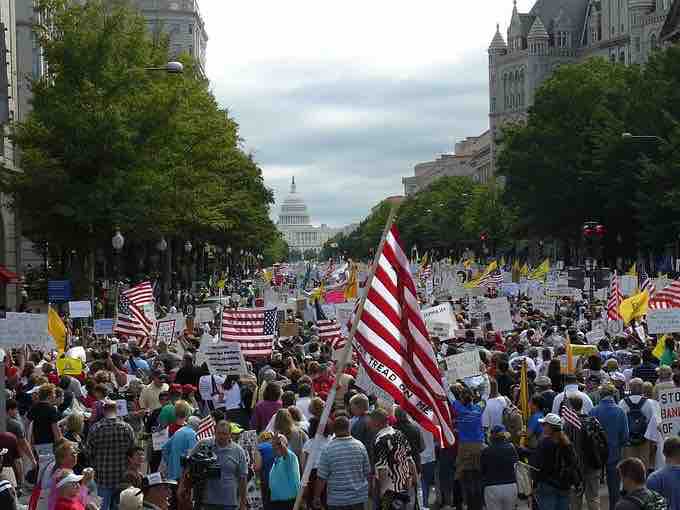Introduction
The organization of parties is generally at three different levels: national, state, and local. National consists of the quadrennial national convention, the party's national chairpersons, and the party's national committee. Next is the state, which consists of state central committees and state conventions, and congressional district committees. Lastly, there is the local level of organizations, which include city and county committees, precinct and ward committees, party activists and volunteers, and party identifiers and voters. Recent trends between the three levels are that they tend to overlap, and more often then not, state and local parties have more influence than the national party around their region, and their decisions tend to override those of the national party .

Tea Party National Rally
Tea Party protesters walk towards the United States Capitol during the Taxpayer March on Washington, September 12, 2009.
The basic structure of a political party would be National Committees, Leadership, National Conventions, States and Localities, and informal groups. National Committees are the national policy creators of each party. Chairpersons are usually selected by the president of the party in power and the party national committee chooses the chairperson for the other party. National conventions are held every four years for nominating presidential candidates. Parties are structured at State and Local levels. Informal groups would be groups like interest groups or the National Federation of Democratic Women.
Both parties also have separate campaign committees which work to elect candidates at a specific level. The most significant of these are the Hill committees, which work to elect candidates to each house of Congress. State parties exist in all fifty states, though their structures differ according to state law, as well as party rules at both the national and the state level.
Political Party Strength in State Governments
Currently, the majority of the overall number of seats held in the state legislatures has been switching between the two parties every few years. As of the U.S. gubernatorial elections of 2010, the Republican party holds an outright majority of approximately 440 with 3,890 seats (53% of total) compared to the Democrat party's number of 3,450 (47% of total) seats elected on a partisan ballot. Of the 7,382 seats in all of the state legislatures combined, independents and third parties account for only 15 members, not counting the 49 members of the Nebraska Legislature, which is the only legislature in the nation to hold non-partisan elections to determine its members. Due to the results of the 2010 elections, Republicans took control of an additional 19 state legislative chambers, giving them majority control of both chambers in 25 states versus the Democrats' majority control of both chambers in only 16 states, with 8 states having split or inconclusive control of both chambers (not including Nebraska); previous to the 2010 elections, it was Democrats who controlled both chambers in 27 states versus the Republican party having total control in only 14 states, with eight states divided and Nebraska being nonpartisan.
Local Government in the United States
Local government in the United States is structured in accordance with the laws of the various individual states, territories, and the District of Columbia. Typically each state has at least two separate tiers of local government: counties and municipalities. Some states further have their counties divided into townships. There are several different types of local government at the municipal level, generally reflecting the needs of different levels of population densities; typical examples include the city, town, borough, and village.
Parties in City Councils
Most cities have City Councils. These are sometimes elected officials who meet for a portion of the year on designated days and hours. There is a president and a president pro tempore in city councils. Usually the majority party (i.e. Democrat or Republican) has the president in their party. The city is split into districts in which the councilman or councilwoman represents.
Linkage Institutions
Linkage institutions provide a way for people to get involved in government and the political process. Political parties provide many ways for individuals to become involved in the political process, from working to get votes or to actually running for office. They are not the only linkage institutions; others include blogs, non-partisan local governments, and school boards.